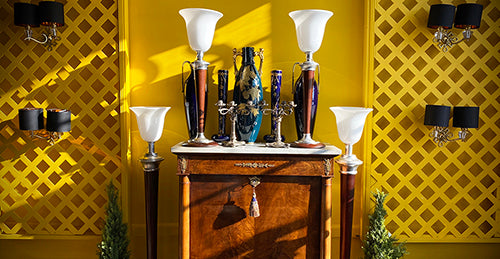Pierre Chareau

THE BIOGRAPHY OF PIERRE CHAREAU
Pierre Chareau was born in 1883 into a family of shipbuilders and attended the École Nationale Supérieure des Beaux-Arts in Paris between 1900-1908. Upon graduating, he worked for the British firm Waring and Gillow Furnishings in Paris until 1913. From 1918 onwards, he worked for himself, taking on primarily furniture and lighting projects as well as the occasional architectural commission. He exhibited with the Société des Artistes Décorateurs at the pivotal 1925 Exposition Internationale des Arts Décoratifs et Industriels Modernes in Paris. In 1929, he was a founding member of the Union des Artists Modernes, a group of SAD dissidents who sought to break with the past and the trappings of “style” in favor of modernist tenets.Chareau linked architecture, fine arts, and style. He designed furniture for avant-garde films and chic homes, and was a radical innovator in the use of materials. Essays by leading scholars embrace the full scope of his invention, offering detailed analyses of individual projects, the interdisciplinary nature of his work, his Jewish background, his place in the avant-garde of Paris between the wars, and his more recent reception. Extensive illustrations present a rich sampling of Chareau’s furniture, architecture, interiors, fabrics, and wallpapers, as well as his own important art collection.
In 1928 Chareau worked, in collaboration with the Dutch architect Bernard Bijvoet, on two architectural projects. The clubhouse in Beauvallon (1928; now altered), near St Tropez, was of reinforced concrete. The interiors were particularly noteworthy for Chareau’s metal and wood furnishings. None of Chareau’s previous work, however, prepares one for the Maison de Verre (1928–32), in Paris, other than his work for the private residence and doctor’s office for Dr and Mme Jean Dalsace. The house embodied the principles of modern building methods. It was constructed with a metal framework that was left exposed on the exterior and interior and infilled with curtain walls of glass brick (see Glass, fig. 7). The interior, bathed in daylight gently diffused by the glass walls, was open-plan but could be divided by curtains or sliding partitions of perforated metal or glass. In 1931, Chareau joined the Union des Artistes Modernes, a Paris-based group of artists, designers and architects, he exhibited with them annually until 1937. In 1940, he migrated to the USA and was soon known in the artistic circles of New York. One of his last works was the studio (1948; destr.) in East Hampton, NY, for the painter Robert Motherwell, constructed from American army surplus materials.
Chareau’s own aesthetic bridged the gap between the studied geometry of Art Deco and the functionalism of International Style modernism. He frequently used rich woods and metals, particularly iron, and embraced the irregularities of hand-worked, unpolished, and hammered metals. None of Chareau’s other projects received such fanfare as the Maison de Verre, but nonetheless his output remained steady, if minimal, even after he emigrated to the USA in 1940. Chareau died in East Hampton, NY in 1950.












